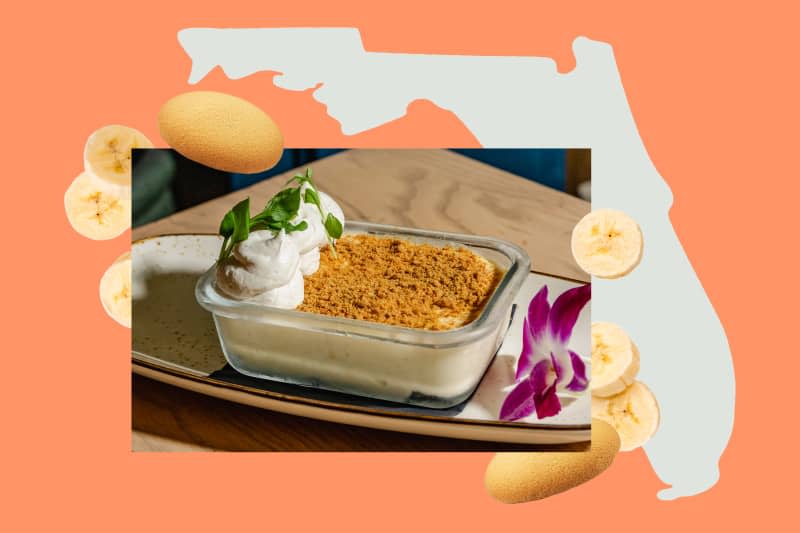Why Black Families Like Mine Celebrate Special Occasions with Banana Pudding

My first bite of banana pudding was at a summer cookout with my then-boyfriend. I had moved to Miami not too long before, and on a sweltering South Florida afternoon he introduced me to his family and to one of his favorite childhood desserts. It was love at first bite — the rich dessert was a surprising combination of creamy, fruity flavors and a crumbly, cookie texture.
Made from layers of vanilla pudding, banana slices, whipped cream, and Nilla wafers, banana pudding is a staple in Southern households and it holds a special place in many Black households today. “I’ve been eating banana pudding for as long as I can remember,” says Chef Kenny Gilbert, vice president of Culinary at Marcus Samelsson’s Red Rooster Overtown in Miami. “I grew up in St. Augustine, Florida, and my grandmother would always make banana pudding around the holidays.”
Geographically, Florida — where I’ve spent the last two decades — might be a Southern state, but it’s not technically considered part of the American South. Yet many Southern traditions have made their way to Florida through Black families migrating south or through sharing recipes at gatherings like family reunions.
“Southern migrants have brought their recipes and cooking techniques to the Sunshine State,” Chef Gilbert says. “Influencing the local cuisine and contributing to its Southern undertones.”
Living in south Florida, I’ve adopted a few Southern food traditions over the years. Thanksgiving always includes baked macaroni and cheese and sweet potato casseroles, and my husband and I now make banana pudding for summer gatherings like the Fourth of July; we serve it to our kids alongside burgers and hot dogs fresh off the grill. It’s a way for us to continue his family’s tradition of banana pudding with our kids and it provides him a sweet dose of nostalgia.
“I first had banana pudding at my grandparents’ when I was a kid,” my husband says when I ask him about his memories of growing up eating banana pudding. “It’s one of those things where as soon as I taste it, it brings me right back to my childhood.”
So how did banana pudding become popular in the South, anyways? After the Civil War, steamships made trade faster and easier, and bananas were brought to U.S. ports like New Orleans and New York from the Caribbean and Central America. The inexpensive fruit was incorporated into various dishes and desserts. The first version of banana pudding actually originated in New York in the late 1800s, if you can believe that. A variation of the English trifle, it was layers of custard, fruit, sponge cake, whipped cream, and bananas for the fruit. Today’s popular banana pudding recipe that most of us know and love with Nabisco Nilla wafers first appeared in an Illinois newspaper in 1921; soon after publication, the cookie company began printing the recipe on its boxes.
With easy access to bananas in the South, the dessert flourished and over the years has become associated with Southern comfort foods.
“Southern cuisine is known for using simple and readily available ingredients,” Chef Gilbert says. “The popularity of banana pudding can be attributed to the fact that it’s comforting and relatively inexpensive to make.”
For many Black Americans in the South, banana pudding was served at Sunday dinners and family reunions, cementing its status as a beloved dessert. The dish made its way to kitchen tables all over the country in part because of The Great Migration, which started in 1920 and lasted through 1970, and resulted in millions of Black Americans moving out of the Southern states into Northern, Midwestern, and Western states and taking their recipes with them. Although they were separated by thousands of miles, serving Southern dishes like banana pudding was a way for Black Americans to keep ties with their Southern roots.
“I don’t think I have ever been to an African American gathering and banana pudding wasn’t present,” Chef Gilbert says.
“For me it holds a special place, as my grandmother loved making desserts and banana pudding was always in her rotation.”
Today, there are several versions of banana pudding; some versions are topped with layers of meringue or include a layer of cream cheese. Chef Gilbert’s rendition of his nana’s banana pudding takes a few liberties and swaps out a few staple ingredients. “At Red Rooster, our banana pudding is infused with a hint of banana liqueur and bourbon,” Chef Gilbert explains. “We also swap out traditional vanilla wafers for gingersnap cookies, adding an extra dimension to this dessert.”
Since that afternoon I had my first taste of banana pudding, it’s become my family’s go-to dessert for summer get-togethers and barbecues. The combination of the creamy pudding, fresh bananas, and crumbly wafers atop the cool whipped cream is a sweet reprieve on hot summer days and a testament to the endurance of Southern food traditions.
